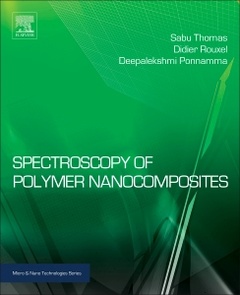Spectroscopy of Polymer Nanocomposites Micro and Nano Technologies Series
Coordonnateurs : Thomas Sabu, Rouxel Didier, Ponnamma Deepalekshmi

1. Spectroscopy: Advantages and application areas of polymer nanocomposites- State of the art, new challenges and opportunities
2. An overview of nanocomposite nanofillers & their functionalization
3. Thermodynamics, phase segregation, polymer morphology and interface/ interphases in polymer nanocomposites
4. Raman and tip-enhanced Raman scattering spectroscopy studies of polymer nanocomposites
5. Infrared and Fourier transform infrared spectroscopy for nanofillers and their nanocomposites
6. Ultraviolet and visible spectroscopy studies of nanofillers and their polymer nanocomposites
7. Fluorescence spectroscopy of nanofillers and their polymer nanocomposites
8. NMR spectroscopy of polymer nanocomposites
9. EPR spectroscopy of polymer:fullerene nanocomposites
10. Dielectric spectroscopy and stimulated current analyses of polymer-ceramic nanocomposites
11. Photothermal spectroscopy of polymer nanocomposites
12. Brillouin spectroscopy of polymer nanocomposites
13. Mössbauer spectroscopy of polymer nanocomposites
14. X-ray diffraction spectroscopy of polymer nanocomposites
15. X-ray photoelectron spectroscopy of nanofillers and their polymer nanocomposites
Dr. Thomas is the Vice-Chancellor and a Professor of Polymer Science and Engineering at Mahatma Gandhi University, India. Additionally, he serves as the Director of the School of Energy Materials at the same institution. Dr. Thomas is internationally recognized for his contributions to polymer science and engineering, covering polymer nanocomposites, elastomers, polymer blends, interpenetrating polymer networks, polymer membranes, green composites, nanocomposites, nanomedicine, and green nanotechnology. His groundbreaking inventions in polymer nanocomposites, polymer blends, green bionanotechnological, and nano-biomedical sciences have significantly contributed to the development of new materials in the automotive, space, housing, and biomedical fields. Dr. Thomas has been conferred with Honoris Causa (DSc) by the University of South Brittany, Lorient, France.
Dr. Didier Rouxel is a Professor at the Institut Jean Lamour, Université de Lorraine, France. Prof. Rouxel has been involved in the spectroscopic analysis of inorganics and is vastly experienced in the analysis of polymer nanocomposite systems by almost all spectroscopic techniques. His major areas of interest include elastic properties of polymeric materials studied by Brillouin spectroscopy, development of polymer nanocomposite materials, development of micro-devices based on electro-active polymers, piezoelectric nanocrystals, microsensor development for surgery, cell excitement in organic medium by piezoelectric polymers etc. He has written 80 publications, 6 book chapters and 138 communications.
Dr. Deepalekshmi Ponnamma is a Lecturer in Materials Science and Technology, at the College of Arts and Sciences, Qatar University. She is a PhD graduate from the Deakin University, Australia, and finished the post-doctoral studies from Qatar University. She has a research experience of more than 10 years with special focus on polymer nanocomposites and various nanomaterials. Dr. Ponnamma has more th
Date de parution : 02-2016
Ouvrage de 498 p.
19x23.3 cm
Thèmes de Spectroscopy of Polymer Nanocomposites :
Mots-clés :
57Fe isotope; Acoustic phonon; Brillouin spectroscopy; Carbon nanotubes; Carbon nanotubes (CNTs); Charge; Chemical methods of dispersion; Clay; Clays; Conjugated polymer; Covalent functionalization; Current; Dielectric; Dispersion; Dynamics; Elastic constant; Environmental remediation; Expanded graphite (EG); Fluorescence; Fourier transform infrared (FTIR) spectroscopy; Fullerene; Functionalization; Graphene; Impedance; Infrared (IR) spectroscopy; Interaction; Interface; Interfacial thermal resistance; Light scattering; Light-induced electron paramagnetic resonance (LEPR); Luminescence; Mechanical properties; Mechanism; Metal oxide nanoparticles; Metallic nanoparticles; Nanocomposite; Nanocomposites; Nanodielectric; Nanofiller; Nanofillers; Nanomaterials; Nanoparticle; Nanoparticles; Neutron reflectivity; Nuclear magnetic resonance; Optical properties; Organic nanocomposite; PPy; PPy-WO3 nanocomposite; Photothermal methods; Physical methods of dispersion; Polaron; Polymer; Polymer matrix nanocomposite; Polymer nanocomposite; Polymer nanocomposites; Polymer nanocomposites (PNCs); Polymers; Polymer-nanofiller interactions; Properties; Qualitative analysis; Quantitative analysis; Raman spectroscopy; Refractive index; Refractometry; Relaxation; Silica; Small-angle X-ray scattering; Solid state; Solubility; Solution behavior; Speciation; Spectroscopy; Spin exchange; Static light scattering; Stimulated; Structure; Surface modification; Thermal conductivity; Thermal diffusivity; Tip-enhanced Raman scattering; Transparency; UV absorption; WO3; Wide-angle X-ray scattering; X-ray photoelectron spectroscopy (XPS)



